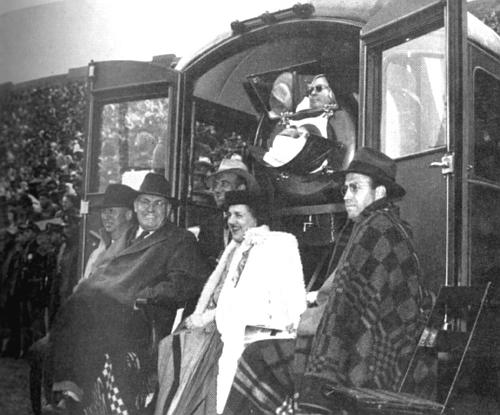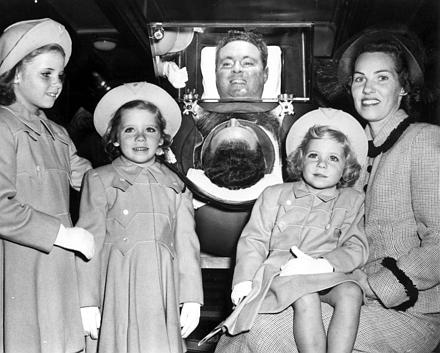
Notre Dame's Grotto / by Dorothy V. Corson

The Fifth Horseman
According to his wife, Teresa, another admirer of Father John O'Hara, during his years as Prefect of Religion was Frederick Snite. She said her husband also spoke of him as a spiritual presence on the campus and a great inspiration to the students.
The family of Frederick Bernard Snite, Jr. donated the Snite Museum. Throughout the greater part of his life, Frederick was known as "The Man in the Iron Lung." His story was told in the December 6, 1946 Scholastic :
On football weekends you would see Fred B. Snite in his house-trailer-like vehicle parked on the sidelines. Through a specially built mirror attached to his iron lung, which he brought into the public limelight, he watched the game. Despite his handicap he followed the fortunes of the Fighting Irish, seeing all the Notre Dame home games he could and listening to away games by radio.
Fred Snite . . . the scion of a wealthy Chicago financier . . . graduated from Notre Dame in the spring of 1933. Two years later he was ready to enter his father's business, but to celebrate the event properly, the elder Snite took his family . . . on a world cruise. Snite was to enter the Chicago loan firm upon his return. But things didn't work out that way; fate had smiled in another direction. In China, Fred Snite was suddenly taken ill while on a plane trip to Peiping. . . . Taken to a Peiping hospital after precious time had been lost and after a local physician had misdiagnosed his ailment, Snite was pronounced critically ill with the dreaded poliomyelitis, or infantile paralysis. Fortunately the only 'iron lung' in China was at that time in Peiping. Snite, unable to speak or breathe without artificial aid was placed in the lung, and little hope was held for his recovery.
However, the doctors didn't reckon with Snite's pluck. With splendid disregard for cynical predictions, Snite remained alive and within a few months he was not only talking again, but was speaking Chinese almost as fluently as a native. He never complained about his plight, but accepted it philosophically. In 1937, after his case had been making the headlines for a year, Snite was returned by boat to the United States. The following year he was again watching Notre Dame football . . . from a spot directly behind the goal posts.(224)

On a trip to the Grotto of Our Lady of Lourdes in France in 1939, Fred Snite returned with three relics which he gave to the University of Notre Dame; a small piece of wood, a small stone from the Grotto, and a framed letter written by Bernadette to a friend.
Grantland Rice, the sports writer, rose to lyric heights in celebrating Rockne's fighting backfield by proclaiming them the 4 Horseman, victors of the backfield. For his courage in battling his disease and his victory over his disabilities, Fred Snite was dubbed "The 5th Horseman":
Condemned to spend a life of pain in a cumbersome Iron Lung, this Fifth Horseman of Notre Dame showed indomitable courage. His special trailer in which he traveled throughout the nation was a familiar sight at the north ramp of Notre Dame stadium at home games. He was indeed, one of Notre Dame's all-time great competitors.(225)
His own words from, The Man in the Iron Lung expressed his philosophy:
"The faith that brought me peace also taught me that this life is a preparation for the next. In other words, I had a job to do like everyone else. I had not been left out." -- Frederick Bernard Snite, Jr. in a prepared statement published in the Miami Herald, March 2, 1952.
He did his job well. His story like that of thousands of other handicapped people, is a success story. The public never saw him without a smile on his face, and those of us who were close to him can tell you that an hour rarely passed without a little joke on his lips. If he ever sang the blues, nobody heard him not even those of us who were with him hourly, day after day.
The man in the iron lung was no Superman. The radiant spirit that was to become his did not develop overnight. It was the product of a long struggle. The words of one of Frederick's favorite nurses, and a devoted friend, echoed many of his former nurses: "as long as I live, the memory of Mr. Snite's thoughtfulness will never die."
One day Frederick mentioned Lourdes. "If it's God's will that I be cured, I will be. If not, I won't; obviously He has other plans for me. Whatever happens. I figure I have a right to ask only one thing: the strength to face up to it."
Father Matthew Walsh speaks of Snite's Grotto experience at Lourdes:
"To Frederick at Lourdes," says Father Walsh, came, "the miracle of resignation. Our Lady procured that for him beyond any doubt, and he never hesitated to give her credit for it." Fred had a good faith, of course, before he went to Lourdes. He had already reached a degree of resignation. But, as he used to point out, he never before had had the deep well of peace that was his the day he came up from the waters of Lourdes after the doctor and others tried to persuade him to keep out of the piercingly cold baths (he went in twice).
"After that he had the untroubled conviction that he would not be cured. In later years, he had the depth of resignation to tell me more than once that if God gave him the choice of getting well or staying in the lung, he would stay put.
"He sent out countless messages of cheer to sufferers all over the world."(226)

"There was no room for self-pity or bitterness in his life which, apart from almost complete confinement in the respirator, was surprisingly normal. He married Teresa Larkin in 1939, and they had three daughters. . . He became a symbol of the triumph of the spirit over the body. The image of 'The Boiler Kid' was frequently seen in newspapers, magazines, and newsreels nationwide. He published a newsletter entitled, appropriately, Back Talk, and his optimism encouraged countless other polio victims. . . . At his funeral in 1954, at the age of 44, he was mourned by many more than the 1500 who came to say farewell to this remarkable, dauntless young man." [Excerpts from information circular "The Fred B. Snite Family," Snite Museum of Art.]
Teresa Snite, Frederick's wife, graciously supplied information about his Grotto experiences. She said there was no doubt that he had been inspired to go to Lourdes by the Notre Dame Grotto. In going there," she said, "he felt he had received a miracle of grace rather than a healing, a total acceptance that it was what God wanted him to do, that his respirator was his ticket to heaven."